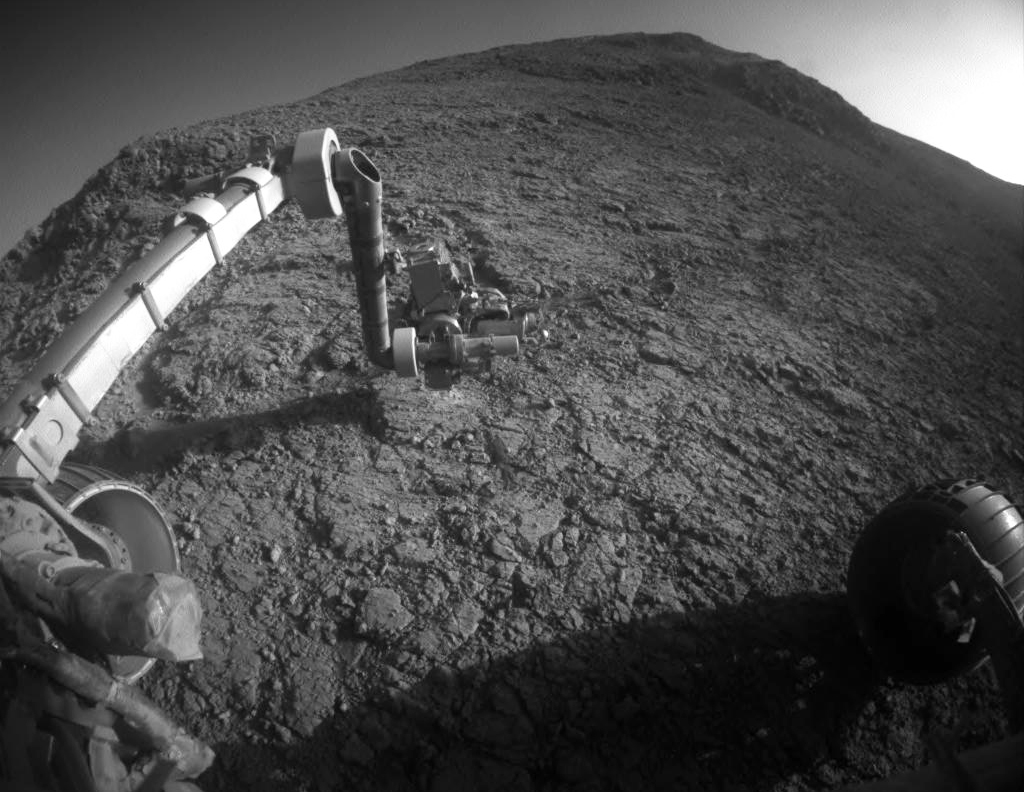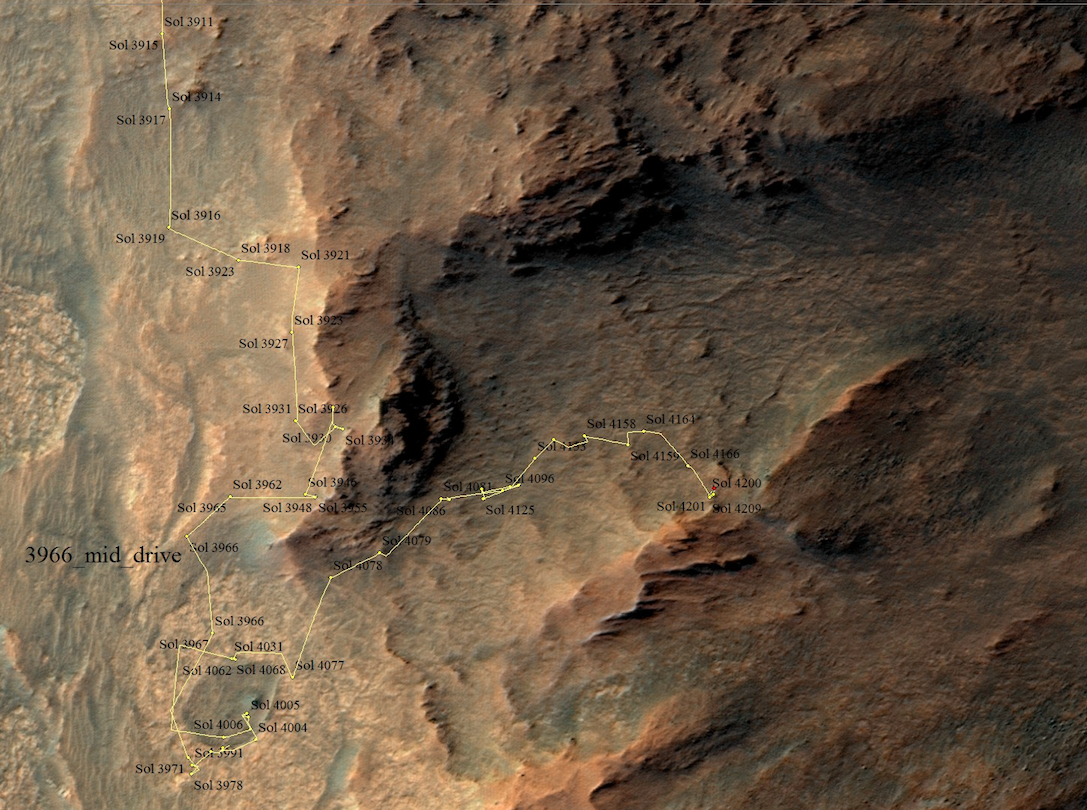
We’ve all seen the commercials for the Energizer Bunny, which keeps going and going and going. … It just never seems to stop. This makes for an interesting analogy with the Opportunity rover, which is just now passing its 12th anniversary on Mars. Not just 90 days, as hoped for, but 12 years and counting. Incredible. And in that time, Opportunity has helped to fundamentally alter our understanding of this fascinating world.
Opportunity landed on Jan. 24, 2004, PST (early Jan. 25, UTC), to begin its mission in Meridiani Planum. Opportunity was designed to search for clues relating to the potential habitability of Mars in the ancient past, including water. It has done that, and more, in spades. It didn’t take long to find the first clues; the rover happened to land inside a very small crater called Eagle crater, sort of like a hole-in-one. The first images showed outcrops of bright bedrock inside the crater which yielded valuable information about wet, albeit acidic, environmental conditions long ago.
The rover went on to explore much more of the landscape in the region, including the very flat plains of Meridiani itself as well as huge craters. The more it searched, the more it found still more evidence that Meridiani Planum used to be a very wet place, with salty playa lakes and groundwater. Although the water, at least for the most part, was acidic, it was still potentially habitable, perhaps for extremophile-type microorganisms. Opportunity discovered that the ground was covered by many tiny round “spherical pebbles” which were nicknamed “blueberries” and turned out to be a form of concretion composed of hematite, which again pointed to much more water in the distant past than there is now. Concretions of various kinds are common on Earth as well. The rover also came across a number of Martian meteorites in its travels, which looked conspicuously different from the other surrounding rocks, and were still in well-preserved condition, given the thin atmosphere and lack of water.


Now, not only is Opportunity celebrating its 12th anniversary, it has also just passed through its seventh Martian winter (Martian years are about 1.9 times as long as Earth years). The winter solstice has also now passed, so the amount of sunshine will continue to increase again through most of 2106. This is critical, of course, since Opportunity is a solar-powered rover, rather than nuclear-powered like Curiosity.
“Opportunity has stayed very active this winter, in part because the solar arrays have been much cleaner than in the past few winters,” said Mars Exploration Rover Project Manager John Callas, of NASA’s Jet Propulsion Laboratory, Pasadena, Calif.
The fact that Opportunity has survived this long is a testament to the incredible engineering that went into building the rover. As of now, the rover has lasted for 4,270 sols (Martian days). That is 48 times longer than expected, so far; not bad for a robotic machine that was only expected to hopefully live past its 90-sol warranty. It is now the longest-running rover mission ever, and has travelled almost 27 miles (43 kilometers) in total to date.

“Twelve years is a very long time to have this sort of a continuous presence,” said Matt Golombek, Mars rovers project scientist. “For a science team to be this involved, on a daily basis, for this long on Mars, is pretty much unprecedented.”
Currently, Opportunity is still on the western rim of the massive Endeavour crater, which is 14 miles (22 kilometers) across, examining rock outcrops in Marathon Valley. The rover has been on the rim since August 2011. Clay minerals have been identified in this region by the Mars Reconnaissance Orbiter, which would have formed in a wet, but non-acidic environment. Such an environment would have been even more potentially habitable, similar to the evidence found so far by the Curiosity rover in Gale crater, for ancient lakes and rivers which were also non-acidic.
Opportunity’s rock abrasion tool has been used most recently here to remove surface crust from a rock called “Private John Potts,” nicknamed after a member of Lewis and Clark’s expedition, and other instruments are now analyzing the interior. Since the rover is now on the south side of Marathon Valley, it can keep its solar panels oriented toward the Sun. Recent winds have also removed more dust from the solar panels. While the rover doesn’t have a mechanism for manually removing dust, Martian winds have periodically done so themselves in “dust-cleaning events.”
“With healthy power levels, we are looking forward to completing the work in Marathon Valley this year and continuing onward with Opportunity,” Callas said.
Opportunity may be showing its age, but it is still active and overall quite healthy, continuing to return incredible image and other data from Mars. Its solar panels are currently generating over 460 watt hours per day, enough to keep science operations continuing, including driving and rock-grinding. This is the first winter that Opportunity did not need to hibernate.
“Every day, you’re looking at images that no one has ever seen before,” said Callas. “In that sense, it’s always new, it’s always fresh.”
Opportunity’s rover twin, Spirit, also landed in January 2004, in Gusev crater, but became stuck in sand in 2009 and was unable to be rescued. Its last transmission was in March 2010. Spirit also found evidence for past water, but again mostly acidic, as well as possible ancient hydrothermal activity such as hot springs.

After a nail-biting waiting period, Opportunity is now funded again through 2016. There had been concern that the new budget would mean having to shut down the rover prematurely, even though it was still healthy and active. According to Emily Lakdawalla of The Planetary Society, it should remain funded now as long as it is still functioning and able to return science data:
“Generally speaking, if you have a spacecraft that is functional, that is responding to you, that is already at a distant planet, it is worth it to continue to put what effort you can in to get science out of it.”
Of course, one day Opportunity’s mission will end, but hopefully that day is still a long ways off. Opportunity has contributed immensely to our understanding of Mars’ past, along with Spirit and Curiosity and other previous landers and orbiters. Ground truth is always important, because most observations of Mars had been done more remotely, from orbit. Opportunity was not designed to look for life itself, but it has helped scientists to figure what conditions were like long ago, and how hospitable the environment could have been, at least for microscopic life. Together with other missions, it has found that early Mars could indeed have supported life, but whether it actually did or not is the question still to be answered.
More information about the Opportunity mission is available here.
Want to keep up-to-date with all things space? Be sure to “Like” AmericaSpace on Facebook and follow us on Twitter: @AmericaSpace
Missions » InSight » Missions » MOM » Missions » MAVEN »




Who would have thought it possible? Incredible!